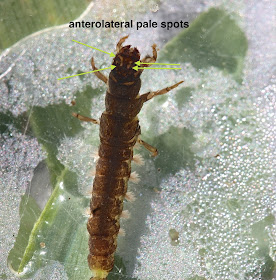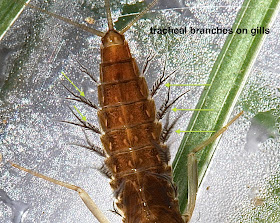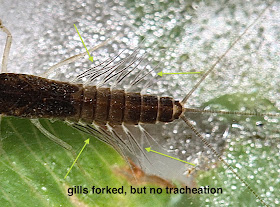The Rivanna is still running high and fast -- but it's clear. So I was able to turn over some rocks -- and sort through vegetation -- close to the shore in Darden Towe Park.
The small minnow mayfly at the top of the page -- Heterocloeon curiosum -- is the most common Baetid we see in this stream in the summer, and this morning there were a lot of them on the rocks. I now know them by sight, but with a loupe you can pick out a distinguishing feature: the gray pigmentation at the center of each of the gills.
But to be sure of your ID, you have to see the "forecoxal gills," finger-like projections at the base of the front legs. These:
No need for a microscope if you can get a photo like that! Like many small minnow mayflies, H. curiosum nymphs are sexually dimorphic -- males and females have different colors and patterns. That's a male at the top of the page, and this is a female:
Note the pale colored "U" on the thorax of the male. And here's a photo of male and female together. (I almost always find them together.)
By the way, don't be mislead by this photo, in which the male is the larger of the two: female nymphs, when mature, are always larger than males. H. curiosum is an insect I look forward to seeing here in the summer. I've only seen them in one other stream: the Moormans River, especially at Free Union Bridge.
________________
And of course there were lots of common netspinners around: it's the most common insect we see in the Rivanna in summer. They love the gnarly vegetation that grows on the rocks in the river, though today I couldn't get out to those rocks. The netspinner I most commonly see in the Rivanna is Hydropsyche venularis, and that's the one I ran into this morning.
This one we ID by noting two features: 1) the pale, anterolateral dots on the head -- which often merge into a stripe:
And the muscle scars on the side of the head that curve dorsad (upward) at the rear of the head:
H. venularis is a very tolerant caddisfly larva with a TV of 5.1. But then, it has to be to survive the Rivanna in summer where the water can get very warm (it already is). That it needs to draw oxygen from water that has little in it might explain why the abdominal gills seem to be so dense and thick on this species.
________________
Sure hope the water keeps dropping so I can get back here more often. You don't have to struggle to find things in here in the summer.


















































